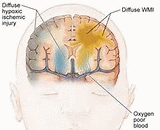Hypoxic Ischemic Encephalopathy (HIE)
HIBD; NE; Hypoxic-ischemic brain damage; Neonatal encephalopathy

HIE is defined by signs and symptoms of abnormal neurological function in the first few days of life in an infant born at term. It is commonly caused by birth asphyxia. Cord blood gas analysis can be used to determine if there is perinatal hypoxia/asphyxia, which are potential causes of hypoxic-ischemic encephalopathy or cerebral palsy, and give insight into causes of intrapartum fetal distress. Cord blood gas analysis is indicated for high-risk pregnancies, in cases where C-sections occurred due to fetal compromise, if there were abnormal fetal heart rate patterns, Apgar scores of 3 or lower, intrapartum fever, or multifetal gestation.Evidence of brain injury related to the hypoxic-ischemic events that cause neonatal encephalopathy can be seen with brain MRIs or magnetic resonance spectroscopy imaging.
Organism species: Mus musculus (Mouse)
- Disease model DSI685Mu01 Mouse Model for Hypoxic Ischemic Encephalopathy (HIE) In Stock
- Disease model DSI685Mu02 Mouse Model for Hypoxic Ischemic Encephalopathy (HIE) In Stock
- Customized Service n/a Tissue of Hypoxic Ischemic Encephalopathy (HIE) (If Necessary) Tissue Customized Service Offer
- Customized Service n/a Serums of Hypoxic Ischemic Encephalopathy (HIE) (If Necessary) Serums Customized Service Offer
Organism species: Rattus norvegicus (Rat)
- Disease model DSI685Ra01 Rat Model for Hypoxic Ischemic Encephalopathy (HIE) In Stock
- Customized Service n/a Tissue of Hypoxic Ischemic Encephalopathy (HIE) (If Necessary) Tissue Customized Service Offer
- Customized Service n/a Serums of Hypoxic Ischemic Encephalopathy (HIE) (If Necessary) Serums Customized Service Offer
Organism species: Cavia (Guinea pig )
- Customized Service n/a Model for Hypoxic Ischemic Encephalopathy (HIE) Disease Model Customized Service Offer
- Customized Service n/a Tissue of Hypoxic Ischemic Encephalopathy (HIE) (If Necessary) Tissue Customized Service Offer
- Customized Service n/a Serums of Hypoxic Ischemic Encephalopathy (HIE) (If Necessary) Serums Customized Service Offer
Organism species: Oryctolagus cuniculus (Rabbit)
- Customized Service n/a Model for Hypoxic Ischemic Encephalopathy (HIE) Disease Model Customized Service Offer
- Customized Service n/a Tissue of Hypoxic Ischemic Encephalopathy (HIE) (If Necessary) Tissue Customized Service Offer
- Customized Service n/a Serums of Hypoxic Ischemic Encephalopathy (HIE) (If Necessary) Serums Customized Service Offer
Organism species: Canis familiaris; Canine (Dog)
- Customized Service n/a Model for Hypoxic Ischemic Encephalopathy (HIE) Disease Model Customized Service Offer
- Customized Service n/a Tissue of Hypoxic Ischemic Encephalopathy (HIE) (If Necessary) Tissue Customized Service Offer
- Customized Service n/a Serums of Hypoxic Ischemic Encephalopathy (HIE) (If Necessary) Serums Customized Service Offer
Organism species: Sus scrofa; Porcine (Pig)
- Disease model DSI685Po01 Porcine Model for Hypoxic Ischemic Encephalopathy (HIE) In Stock
- Customized Service n/a Tissue of Hypoxic Ischemic Encephalopathy (HIE) (If Necessary) Tissue Customized Service Offer
- Customized Service n/a Serums of Hypoxic Ischemic Encephalopathy (HIE) (If Necessary) Serums Customized Service Offer


